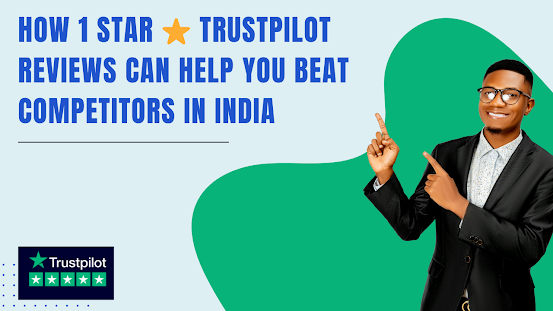In today’s competitive business landscape, customer reviews are one of the most powerful tools for gaining insight into a company's strengths and weaknesses. While positive reviews can boost a brand’s reputation, negative feedback—especially those with 1-star ratings—can be just as revealing, if not more. If you’ve ever browsed a Trustpilot review page, you’ve likely noticed how some businesses respond to complaints, while others fall short. But did you know that a 1-star Trustpilot rating can actually help expose your competitor's weaknesses?
In this article, we’ll explore how 1-star ratings on Trustpilot reviews can provide valuable insights into your competitors' flaws and how businesses can use this information to strategically position themselves for success.
The Power of 1-Star Reviews on Trustpilot
Trustpilot is a popular review platform where customers can share their experiences with businesses, from product quality to customer service. With millions of reviews, Trustpilot offers an invaluable treasure trove of information. However, not all reviews are glowing—some are filled with complaints, frustrations, and, most importantly, glaring weaknesses that competitors can exploit.
Why 1-Star Ratings Are Goldmines for Competitors?
1-star ratings are often filled with specific details about why a customer was dissatisfied, whether it's due to poor customer service, subpar products, or broken promises. These negative reviews can shine a spotlight on areas where competitors fall short, giving businesses a chance to capitalize on these weaknesses.
For example, if a competitor consistently receives 1-star reviews for long wait times or unhelpful staff, it’s an opportunity for your business to highlight how quickly and efficiently your team operates. These types of insights are valuable because they reveal the actual pain points that customers experience—something that can be hard to uncover through traditional market research.
Real-World Example: Airline Industry
Let’s consider the airline industry. If one airline has a number of 1-star ratings for late flights and poor customer service, customers looking for a reliable flight experience may be drawn to an airline with a strong reputation for punctuality and excellent customer service. As a competitor, you can use the insights from those 1-star reviews to promote your own strengths in these areas and build customer trust by addressing these specific concerns.
How 1-Star Reviews Expose Weaknesses?
The complaints in 1-star reviews often reveal deeper weaknesses within a business. These weaknesses might not be immediately obvious but can have a long-term impact on customer satisfaction and retention.
1. Customer Service Failures
A common theme among 1-star reviews is poor customer service. Customers often express frustration over unresponsive support, lack of communication, or the feeling that their concerns are ignored. These issues are particularly damaging because they can lead to a tarnished reputation and lost business.
2. Product Quality Issues
Many 1-star reviews are driven by customers being dissatisfied with the quality of the product or service they received. Whether it’s faulty products, misleading descriptions, or subpar performance, these reviews are a window into the actual quality of a competitor's offerings.
3. Missed Promises
Businesses that fail to deliver on their promises are often exposed in 1-star reviews. Customers who feel that a company didn’t meet its advertised expectations will leave a negative review, providing valuable information to the competitor who is meeting those promises.
4. High Prices Without Value
1-star ratings can also indicate that customers feel they didn’t get their money’s worth. If a competitor is charging high prices for subpar products or services, this can be a point of contention in their reviews.
How to Use 1-Star Reviews to Your Advantage?
Once you’ve identified the weaknesses revealed by 1-star Trustpilot reviews, it's time to use this information strategically. Here’s how:
1. Position Your Brand as the Solution
When you spot recurring complaints in 1-star reviews, highlight your business’s ability to address those exact issues. Whether it’s offering better customer service, more reliable products, or transparent pricing, make sure your marketing and communications emphasize how your business solves the problems that others fail to address.
2. Create a Compelling Value Proposition
Use the weaknesses revealed in 1-star reviews to strengthen your value proposition. For example, if competitors struggle with poor customer service, focus on showcasing how your customer service is efficient, empathetic, and accessible.
3. Respond to Reviews with Empathy and Transparency
If you’re on the receiving end of a 1-star review, respond promptly, professionally, and with empathy. Acknowledge the complaint, apologize if necessary, and offer a clear solution. This not only improves customer trust but also shows potential customers that you care about their experiences and feedback.
4. Monitor Your Competitors
Keeping an eye on your competitors’ reviews on Trustpilot (and other platforms) is essential for staying ahead. Regularly check their 1-star reviews to identify new weaknesses you can exploit. This helps you stay informed and adjust your own strategies accordingly.

Comments
Post a Comment